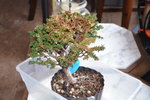Tidal Bonsai
Omono
Yesterday, a friend and I were repotting some junipers at my place. She brought this beautiful, yet unhappy Utah Juniper to get the field soil out. It didn’t have many roots, and the foliage is questionable, but I am an eternal optimist! At least it seems to be backbudding in two places!
It’s going on my greenhouse for consistent heat/light/watering to give it the best chance for success. Is there any foliar feed anyone can recommend to aid in its recovery, or is careful H2O all it needs?
It’s going on my greenhouse for consistent heat/light/watering to give it the best chance for success. Is there any foliar feed anyone can recommend to aid in its recovery, or is careful H2O all it needs?




